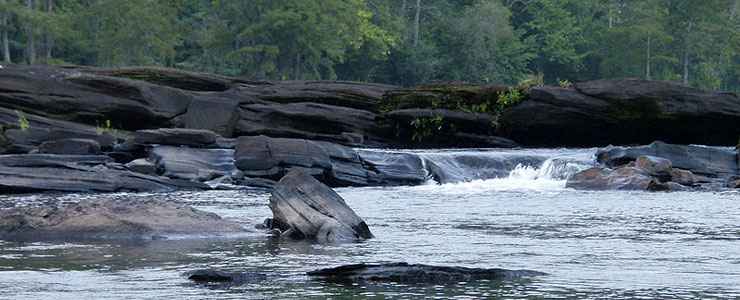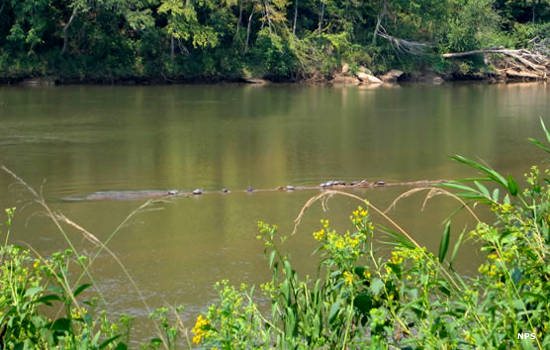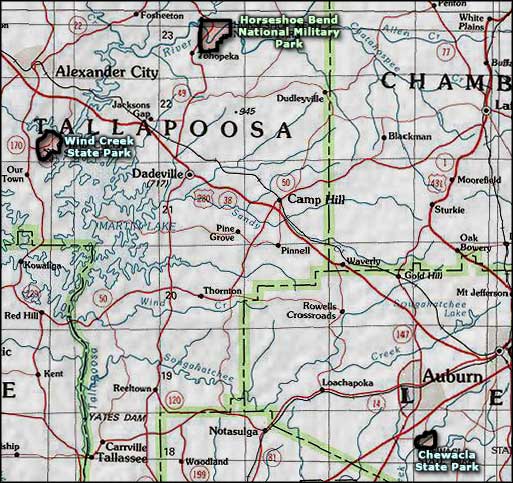Horseshoe Bend National Military Park

The Tallapoosa River Shoals, Horseshoe Bend National Military Park
Horseshoe Bend National Military Park preserves the site of the last battle between the local white militias and the Creek Nation on March 27, 1814. The Tennessee Militia, led by General Andrew Jackson and beefed up with elements of the 39th U.S. Infantry Regiment and allied Cherokee and Lower Creek warriors, met with a large number of Red Sticks Creek warriors here (Red Sticks in this usage refers to Creeks who opposed the unrestrained encroachment of white culture on Creek lands and Creek society). As this was during the time of the War of 1812, the Red Sticks faction were allied with Great Britain and opposed the ongoing encroachment of American settlers on Creek territory. The Lower Creek and Cherokee had a reasonable relationship with their respective Indian Agents and fought with the Americans in an effort to remain on good terms with the federal government.

After several months of Red Sticks attacks on white farms, where they burned the buildings and croplands, they attacked Fort Mims in southern Alabama. Inside the fort were 517 settlers of white and mixed-blood Creek heritage. When the carnage at Fort Mims was over, almost 500 people were dead, 250 of them scalped. The African-Americans in the fort were spared, only to be taken into slavery by the Red Sticks themselves. It was this incident that got the attention of the federal government.
As most of the regular Army was engaged with British forces (this was during the War of 1812), the militias of several states mobilized and attacked several of the towns that supported the Red Sticks. However, it was the battle at Horseshoe Bend that ended the conflict. With 3,300 men, Andrew Jackson attacked about 1,000 Upper Creek Red Sticks warriors and broke the back of the uprising. When it was over, more than 800 of the Creek warriors were dead. This was the single largest loss of Native American lives in a single battle in American history.
The Red Creeks had built a log barricade at Horseshoe Bend and thought they were well-fortified inside it. Jackson had about 700 mounted infantry and 600 Cherokee and Creek allies under General John Coffee go downstream on the Tallapoosa, cross the river and hold their position to prevent the Red Sticks from escaping. With his remaining 2,000 men, Jackson then marched onto the peninsula the barricade was built on and began the engagement with a two-hour cannon bombardment. That had almost no effect on the Red Sticks, so Coffee had some of his Cherokees re-cross the river and attack the Red Sticks from their rear. At the same time, Jackson ordered a full-frontal bayonet assault on the barricade. Within minutes his men were inside and the carnage began. The fighting moved back and forth all over the southern end of the peninsula until, by sundown, there were 557 Red Sticks dead on the battlefield and another 300 or so dead in the river. Jackson's forces lost 49 killed and 154 wounded (of which many died shortly thereafter).

The Red Sticks still held out for several months but finally met with Jackson at Wetumpka (near present-day Montgomery) and surrendered, exhausted and starving.
August 9, 1814 saw the Creeks sign the Treaty of Fort Jackson, a treaty which ceded 23,000,000 acres of their homeland (fully half their ancestral property) to the United States Government. Unhappy with this result, many Creeks traveled south into Florida where they met and merged with other groups of people unhappy with the general nature of United States "citizens" and shortly evolved into the Seminole Nation.

A typical Creek hunting camp
The battle at Horseshoe Bend was one of the major steps in advancing Andrew Jackson toward the Presidency. Another step toward the Presidency was his victory over British troops at the Battle of New Orleans a few months later (shortly after the treaty ending the War of 1812 was signed in Europe and before news of that signing arrived in the US). However, his term in office was marked more by his forcing the evacuation of Native Americans to Indian Territory (Oklahoma) than by his connections with Great Britain. As for the Lower Creeks and Cherokees who fought with Jackson at Horseshoe Bend, they, too, were eventually forced to migrate to Indian Territory and the vast majority of their lands were taken over by the Government Land Office and sold to incoming white settlers. It was the hardship of those forced migrations that created the Trail of Tears.
Horseshoe Bend National Military Park is a 2,040 acre site along the Tallapoosa River in central Alabama. To visit the park is free. The grounds are open from 8 am to 5 pm, the visitor center from 9 am to 4:30 pm. The park is open every day of the year except Thanksgiving Day, Christmas and New Year's Day. In addition, hours are reduced on Christmas Eve and New Year's Eve.

Along one of the nature trails on the Tallapoosa River at Horseshoe Bend

Other photos and maps courtesy of the National Park Service
